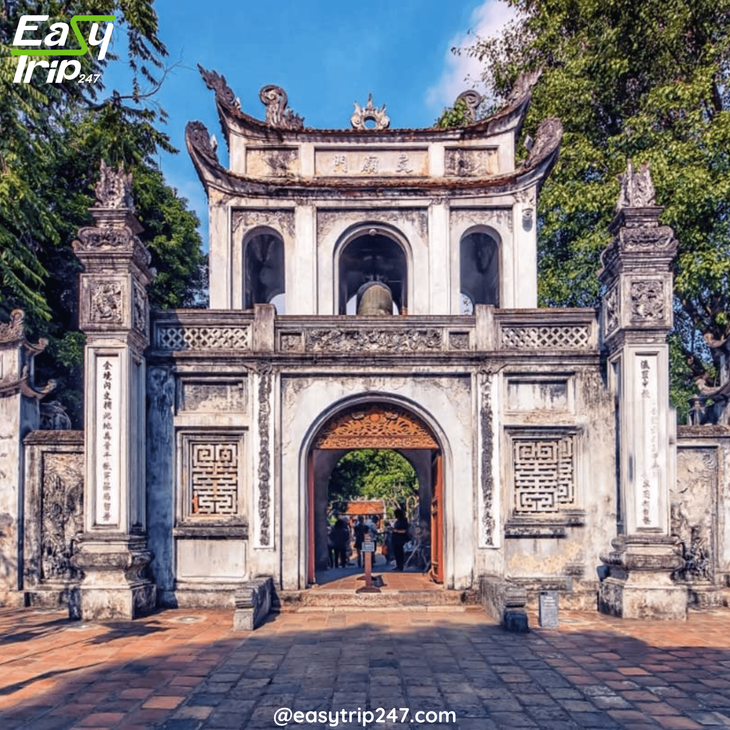Architectural Gems of Hanoi Old Quarter: A Living Museum of Vietnamese Heritage
On
23/06/2025Reading time:
1 min
Summary:
The Hanoi Old Quarter is a sensory experience, where timeworn facades, ancient rooftops, and narrow alleys reveal the soul of a city that has stood resilient for over a thousand years.

What makes the Hanoi Old Quarter architecturally remarkable is its seamless fusion of different time periods and cultures. Unlike other historical districts that feature a singular style, the hanoi old quarter showcases a living blend of indigenous Vietnamese architecture, classical Chinese elements, and colonial French aesthetics. This unique coexistence is the result of Hanoi’s evolution through dynastic rule, international trade, colonial occupation, and modern-day transformation.
One of the most characteristic features of the hanoi old quarter is the famous "tube house." These narrow, elongated buildings—often just a few meters wide but extending deep into the block—are a testament to clever urban planning in a densely populated area. Historically taxed by street frontage, residents built upwards and backwards, resulting in compact homes with rich architectural detail. From intricately carved wooden doors to shaded inner courtyards and tiled roofs, tube houses reflect both practicality and artistry.
Ancient Temples and Communal Houses
Scattered throughout the hanoi old quarter are sacred spaces that represent the spiritual and communal heart of the neighborhood. Temples and communal houses, known locally as "dinh," offer stunning examples of traditional Vietnamese architecture. Many of these structures were built centuries ago and have been lovingly preserved.
Bach Ma Temple, said to be one of the oldest temples in Hanoi, stands proudly on Hang Buom Street. With its curved tiled roof, ornate dragon carvings, and crimson columns, the temple is a perfect representation of Vietnamese spiritual design. As you explore its tranquil courtyards and altars, you gain insight into the religious devotion that has shaped the hanoi old quarter for generations.
Not far away, the Kim Ngan Communal House on Hang Bac Street reflects a different aspect of life—community gatherings and craft guild traditions. Built during the Le Dynasty, its wooden beams and engraved motifs speak of a time when artisan communities held meetings here to uphold trade standards and perform rituals.
Colonial Beauty Along Every Street
The French colonial era left an indelible mark on the Hanoi Old Quarter, and its architectural legacy is still widely visible today. Unlike the grand boulevards of the French Quarter near Hoan Kiem Lake, the hanoi old quarter features more modest but equally charming colonial structures. Shuttered windows, wrought iron balconies, and pastel-painted facades sit gracefully beside traditional Vietnamese homes, creating a visually compelling contrast.
One example is the Ma May Ancient House, a preserved home from the 19th century that is open to the public. This restored house offers a window into the daily life of wealthy merchants during the colonial era. With its timber frames, antique furniture, and French-inspired layout, it perfectly illustrates how East met West within the walls of the hanoi old quarter.
The Charm of Narrow Alleys and Shophouses
Beyond temples and villas, much of the Hanoi Old Quarter's charm lies in its shophouses—multi-story buildings where families both live and conduct business. The ground floor is typically a shop or workshop, while upper floors serve as living quarters. These buildings tell the story of the district’s vibrant commercial history, as the area has long been a hub of trade and artisanal craftsmanship.
Walking down streets like Hang Gai (Silk Street) or Hang Dao (Peach Blossom Street), you’ll see these structures in action. Wooden shutters open to reveal tailors, goldsmiths, and tea sellers, continuing traditions that go back hundreds of years. Some buildings even include French ironwork and neoclassical touches, adding to the hanoi old quarter’s layered personality.
Preserving the Past
In recent years, as tourism and development have grown rapidly in Hanoi, there has been a concerted effort to protect and restore the architectural identity of the Hanoi Old Quarter. Preservation projects have focused on rehabilitating ancient houses, updating infrastructure without compromising aesthetics, and maintaining public awareness of the area’s cultural importance.
The Hanoi Old Quarter Management Board has implemented strict regulations to ensure that new constructions harmonize with the historical context. This allows visitors to enjoy the area as a cohesive cultural experience, rather than one overshadowed by modernity.
Additionally, programs like the walking street initiative—where motorized traffic is restricted on weekends—allow tourists and locals alike to explore the hanoi old quarter more safely and intimately, appreciating its architecture without the distraction of busy roads.
Living History in Every Corner
Perhaps what makes the hanoi old quarter so special is that it isn’t frozen in time. While it retains its historic structures and cultural soul, the area continues to evolve. Families live in homes that are hundreds of years old. Children play in alleys flanked by ancient walls. Daily life buzzes in coffee shops housed in French villas and art galleries set inside traditional tube houses.
Even the cafes and restaurants pay homage to the neighborhood’s history. Whether you're sipping egg coffee at Café Giang—rumored to be the birthplace of this Hanoi specialty—or enjoying traditional bun cha in a rustic courtyard, you're experiencing the hanoi old quarter in the most authentic way possible: as a place where the past lives alongside the present.
Final Thoughts
The architectural gems of the Hanoi Old Quarter are not just buildings—they are storytellers. Each structure, from the most humble shophouse to the grandest temple, offers a glimpse into the history, values, and resilience of the people who have called this neighborhood home for generations. With its layered blend of styles and cultures, the hanoi old quarter offers an architectural journey that is as captivating as it is educational.
For travelers seeking a deeper connection to Vietnam’s history and identity, the hanoi old quarter is the perfect destination. It invites exploration, curiosity, and appreciation—one ancient brick, wooden beam, and painted shutter at a time. So take your time wandering through its narrow streets, look up at the balconies, peek into the courtyards, and remember: in the hanoi old quarter, every corner has a story waiting to be told.
Design Your Tour Today And Get A Quote. Contact Us Here: +84.975.504.825
Source: Easytrip247 Team compiled.
